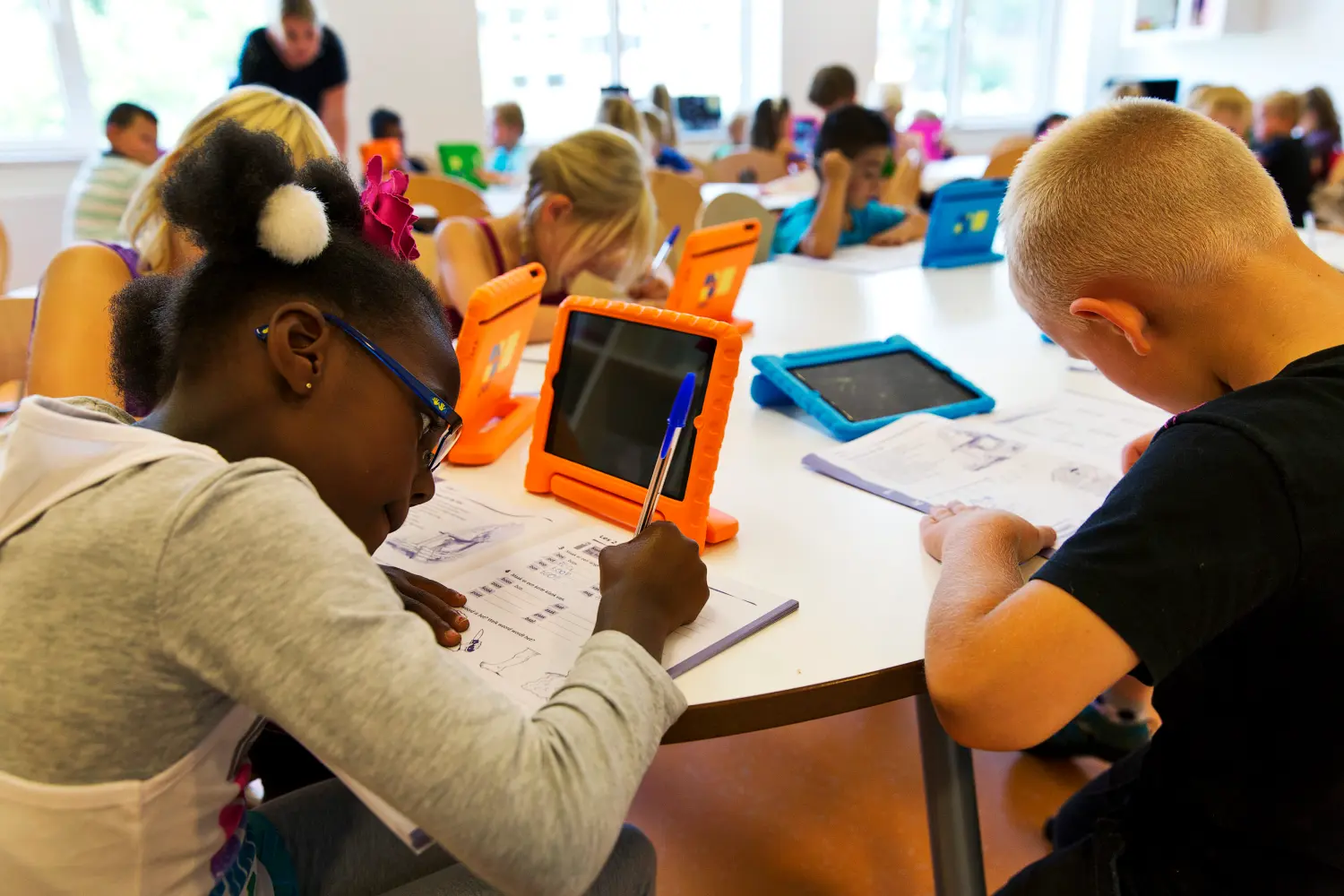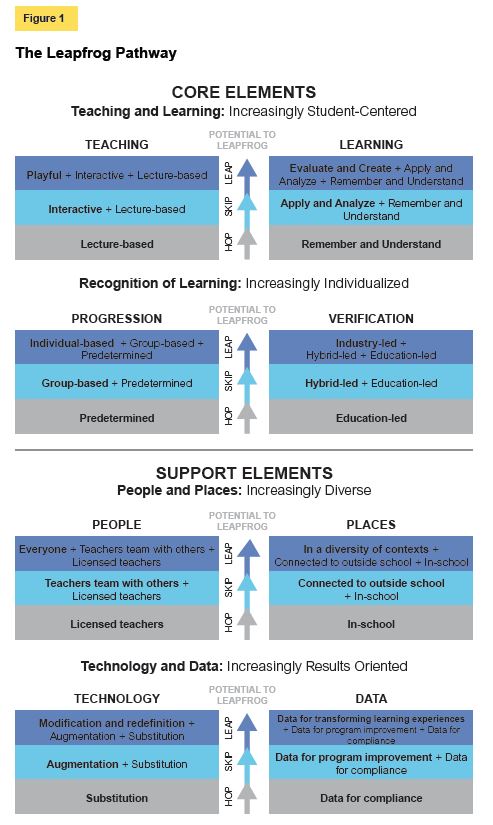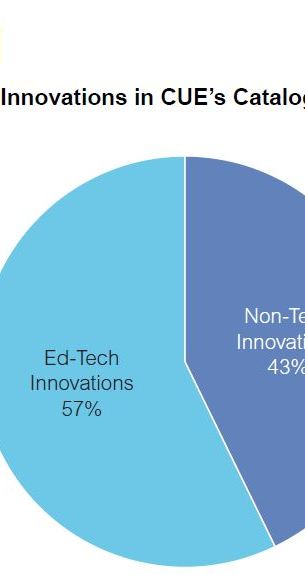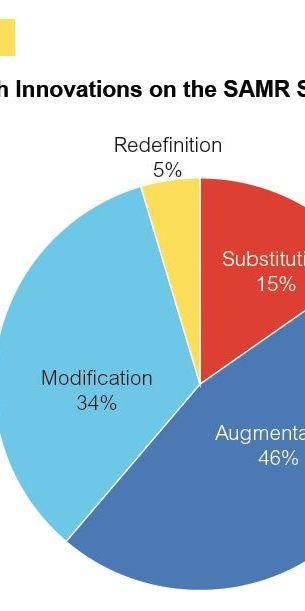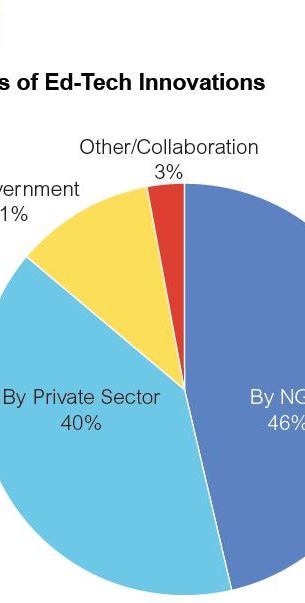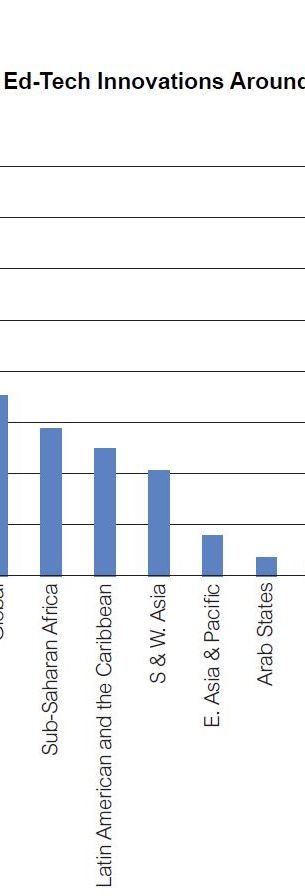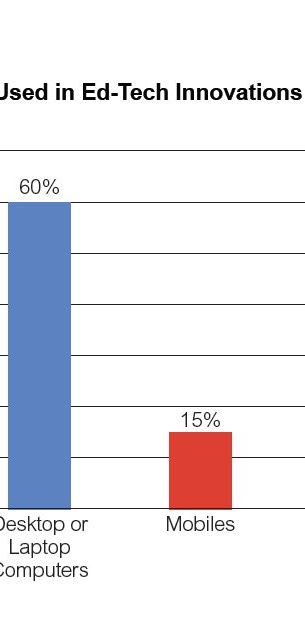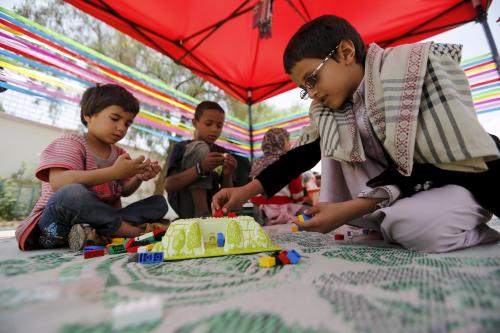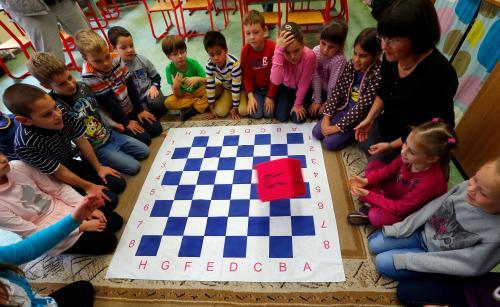From within formal classrooms to educational games after school, technology is widely used in teaching and learning around the world. When used appropriately, technology has the power to support teachers and engage students, providing tools to create and evaluate activities previously considered out of reach.
At the Center for Universal Education (CUE) at the Brookings Institution, we are studying innovations that can rapidly improve education progress, including innovations that use education technology. If the education sector stays on its current trajectory, by 2030 half of all children and young people around the world will lack basic secondary-level skills needed to thrive.1 To change this dire prediction, we must make rapid, non-linear progress, or what CUE calls leapfrogging.
Technology can help education leapfrog in a number of ways. It can provide individualized learning by tracking progress and personalizing activities to serve heterogeneous classrooms. It can support playful learning through approaches such as games. Technology allows students to collaborate and engage with peers in different parts of the world, and it offers platforms for data collection and analysis that lead to improvements in the broader education system.
This brief is the second in a series of Leapfrogging in Education snapshots that provide analyses of our global catalog of education innovations. (Our first snapshot focused on playful learning.2) The catalog and our corresponding research on leapfrogging is explained in depth in CUE’s book, “Leapfrogging inequality: Remaking education to help young people thrive.”3 Of the nearly 3,000 global innovations CUE catalogued, more than one half involve the use of technology, which suggests strong interest in its use and application in aiding educators around the world.
How can technology be used in education?
Simply using technology doesn’t guarantee an impact on learning.4 The introduction of technology in schools has often focused on reinforcing traditional teaching and learning practices, instead of what is truly needed to leapfrog education: applying, evaluating, and creating knowledge. Recent research has shown that, rather than using technology for intense “drill and kill” exercises, technology is successful when it is interactive, includes real-time feedback, and allows students to creatively apply and evaluate what they have learned.5
Technology can augment lessons from teachers, providing details or reinforcement through videos, and support for playful learning experiences. It can provide endless practice problems and track the progress of personalized learning. While a common critique of technology is that it is often unavailable to marginalized groups, this is not always the case. Technology can bring education to students with disabilities that prevent their attendance in typical classrooms, for example. And it can help knowledge and information reach remote or otherwise difficult-to-reach students who do not have other access to classrooms and educational materials.
It is important to note that technology cannot replace teachers, nor is this likely to occur. In fact, a 2016 analysis by McKinsey & Company reported that teaching is one of the least likely professions to be automated.6 When used effectively as a tool to enhance learning, technology has the power to transform the interactions between students and teachers and to lead to increases in student learning.
Catalog analysis
CUE’s global catalog provides a picture of education innovations happening around the world. To create the catalog, we compiled 2,854 education innovations from 16 “innovation spotter” organizations. The innovations range from non-governmental organization (NGO) projects to for-profit products to government initiatives and schools and take place in 166 countries and in 4 languages. We further analyzed the innovations against our leapfrog pathway (see Figure 1), which is a framework CUE developed to show specific steps needed for education interventions to leapfrog. The pathway has two core elements: teaching and learning and recognition of learning. It also has two support elements, not required for leapfrogging but often helpful given the scope of the challenge: people and places, and technology and data.
Of all innovations in the catalog, technology was present in more than half (57 percent)—or 1,640 total—innovations (see Figure 2). The catalog and this snapshot are hardly an exhaustive list of all education technology innovations, but they do provide insights into trends and areas of opportunity for the education community.
| CATOLOG SPOTLIGHT: The iMlango Project, is an NGO-government-private sector consortium led by Avanti Communications, a strategic partner of the Department for International Development’s (DFID) Girls’ Education Challenge. iMlango leverages technology to tailor educational content to students’ needs in rural and semi-urban settings across Kenya. The e-learning program provides individualized math tutoring through the Maths Whizz e-learning platform and digital content for literacy and other broader life skills. iMlango reaches 180,000 students with an emphasis on improving educational outcomes for marginalized girls.7 The project includes in-field student and teacher support and also provides internet connection for communities. A unique aspect of the program is that it generates real-time data on children’s attendance and learning. iMlango has positively impacted learning outcomes, with the progress rate of students utilizing the program for 30–90 minutes per week doubling from the baseline of 0.58 to 1.27 in three and a half years. (A score of 1 indicates progression at the expected rate, while a score below 1 suggests students are not progressing as quickly as expected, and a score above 1 indicates accelerated learning.) In addition, teachers, many of whom at baseline had no information and communications technology (ICT) skills, were able to effectively deliver learning through technology as a result of their training.8 |
The SAMR model
A useful framework for understanding how to use technology effectively in education is the SAMR model, developed by Ruben Puentedura in 2006.9 The SAMR framework focuses on the use of technology in education in four ways: substitution, augmentation, modification, and redefinition. Substitution can be thought of as substituting an analog method, such as quizzes on paper, with a digital version. Augmentation implies an improvement of a function, such as automatically graded worksheets, freeing up teachers’ time.
The other two types of technology use, Puentedura argues, are fundamentally different and align to our view on the potential of education technology innovations to support leapfrogging. Modification allows for significant task redesign, such as aiding the teacher in connecting students with peers from a distant part of the world and exchanging essays to provide feedback with a different cultural perspective. Another example is students using geographical information system mapping technology to transform and display census data in a social studies class. Redefinition means that the use of technology creates an experience that was previously inconceivable. An example is dividing students into groups and having them collaborate on a video tutorial on how to multiply and divide polynomials. This video can then be used in class and posted online so other students can ask questions or discuss the topics covered. Redefinition requires the innovation to expand access to educational opportunities, amplifying active learning, and allowing teachers and students to create and innovate beyond the existing material.
Figure 3 shows the distribution of the ed-tech innovations in our catalog with respect to their leapfrogging potential as defined by the SAMR model. Most of the innovations use technology to augment or modify the educational experience.
Who implements and funds ed-tech innovations?
Of the innovations using technology in our catalog, 46 percent are implemented by NGOs. The second largest implementer is the private sector at 40 percent, while governments make up only 11 percent of implementers. A smaller number of innovations are delivered by other organizations, including religious organizations or by collaborations between NGOs, the private sector, and government.
Most ed-tech innovations in our catalog (87 percent) identified information on their funding sources, and just under half of these financed their operations from more than one source. As shown in Figure 5 below, user fees proved to be the largest source of funds, supporting 37 percent of all catalogued ed-tech innovations. The second largest source of funding was the private sector, supporting 31 percent of innovations. Philanthropic organizations and governments were the third and fourth largest funders, respectively, of technology use in education, in contrast with international aid agencies that only support 9 percent of technology innovations in our catalog.
| CATALOG SPOTLIGHT: EduApp4Syria is an innovation competition funded by the Norwegian Agency for Development Cooperation (Norad) in cooperation with other global development partners. The goal of the project is to provide an engaging digital game-based learning tool for out-of-school Syrian children to help them improve their Arabic skills and psychosocial well-being.10 Two apps were chosen from 78 bids across 31 countries, with final input from refugee Syrian children living in Norway who tested the apps. “Feed the Monster” is a puzzle game that helps the player learn Arabic gradually based on Syrian Arabic language arts curriculum. It has since been adapted in 25 languages. “Antura and the Letters” features multiple mini-games that span the full Arabic primary school literacy curriculum. Both apps are free and can be downloaded for use when offline. Since the original launch, the apps have been installed on over 80,000 mobile devices. There have been marked improvements in oral reading fluency, with 22 hours (Feed the Monster) and 27 hours (Antura and the Letters) of play equivalent to approximately 30 hours of classroom instruction time in early grade reading.11 |
Who benefits from ed-tech innovations?
Of the ed-tech innovations in our catalog, only half identified the specific groups of learners the innovations serve. We analyze these groups below, with the caution that a complete picture of beneficiaries cannot be fully understood. We do, however, find some potential insight into trends and underserved groups. Most of these innovations provide services to multiple categories of beneficiaries spanning various income, geographic, and cultural groups, with 67 percent targeting more than one specific group. As Figure 6 shows, students from low-income households are the most often served group by income level. Ed-tech innovations target children from rural areas slightly more than those in urban settings. Smaller numbers of ed-tech innovations specifically target out-of-school children and ethnic minorities, and an even smaller number of innovations serve child laborers, displaced children, and children in conflict—highlighting a gap in the provision of such interventions.
Primary school-aged children are the largest age group served by ed-tech innovations, accounting for 1,094 innovations, followed by secondary school age-students (Figure 7). It is important to note that many innovations focus on more than one age group of learners.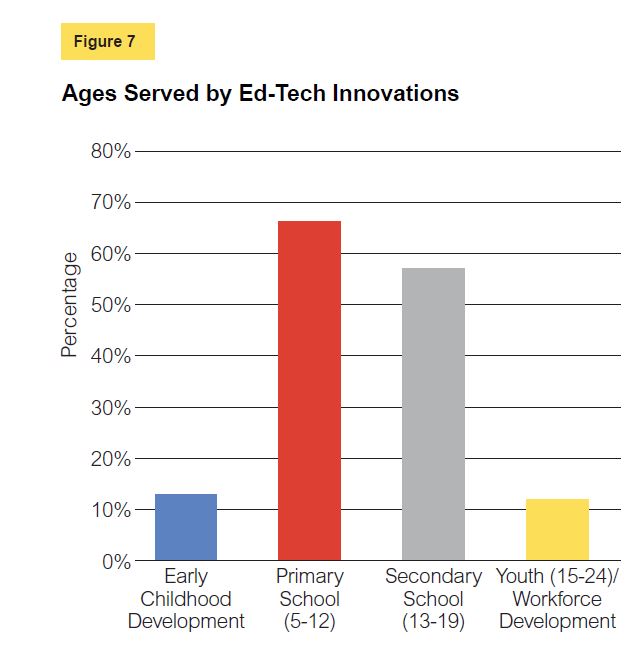
| CATALOG SPOTLIGHT: Benetech, a nonprofit organization in the U.S., offers literacy software that facilitates access to educational content for students with disabilities and promotes inclusivity in the learning process.12 Its Bookshare program is the largest online library of accessible books with 700,000+ titles. It enables access to content in different formats (MP3 players, smart phones, and digital tablets) for free or low-cost to students with qualifying disabilities globally. Other initiatives include an online math platform to improve student-teacher interaction through STEM education tools and an effort to ensure digital learning materials are accessible to people with disabilities from the start. Over 600,000 people across 70 countries utilize Benetech’s programs.13 |
Where in the world are ed-tech innovations?
The ed-tech innovations in our catalog are concentrated in North America and western Europe, with a fair amount present globally (two or more regions) and in Sub-Saharan Africa, Latin America and the Caribbean, and South and West Asia, as shown in Figure 8.
What kind of hardware is used in ed-tech innovations?
Innovations that use desktop or laptop computers are the most common type of technology innovation in our catalog. This is unsurprising, given that this technology is older and more established than comparatively more recent tablets or smartphones. Computers, along with software or a website, can provide lessons, homework, practice, and research materials. Portable laptops allow children to learn at home, extending the time they can benefit from educational games and software. Although in our catalog NGOs are the most common deliverer of ed-tech innovations, the private sector most often delivers innovations through desktop or laptop computers. Programs using desktop or laptop computers focus most often on literacy, followed by 21st century skills.
Like laptops, tablets are a portable way to bring learning to new locations, and they tend to be less expensive than computers. Tablets can introduce gamified innovations to students, provide access to books away from school, and personalize learning through individualized learning plans and projects. In our catalog, the private sector was most likely to deliver an innovation with tablets, with those innovations focused on numeracy, followed by literacy, 21st century skills, and science.
The use of mobile phones in education has increased as phones themselves have become more advanced. Smartphones can provide access to educational apps, dictionaries, translators, textbooks, and more. Mobile phone innovations are most often delivered by the private sector and primarily target literacy. Figure 9 illustrates the breakdown of hardware used in ed-tech innovations.
What are the goals of ed-tech innovations?
The goals of ed-tech innovations range from improving skills or teaching methods to improving access or attendance. They can also improve administrative efficiency by easing financial transactions and maintaining records. The overwhelming majority of ed-tech innovations in our catalog (84 percent) focus on improving students’ skills, whether cognitive or socioemotional (see Figure 10).
How do ed-tech innovations support the learning process?
The use of technology in education can solve a variety of challenges faced by teachers and education institutions. We focus on three below: (1) fostering playful learning; (2) engaging with the community; and (3) supporting or “unburdening” teachers. (See Figure 11.) First, technology can enhance playful, hands-on learning by providing tools to enable interactive learning; for example, a computer science application can help students program a robot or a videoconferencing platform can allow students to engage with peers around the world. Second, ed-tech can increase engagement with students’ communities by extending the focus beyond the classroom walls through students’ virtual interactions with their local and broader communities or by engaging parents via applications to assist with homework help. Finally, ed-tech can support or unburden teachers by freeing their time from administrative tasks or providing a platform where students learn at their own pace through an application.14
Fostering playful learning
Fostering hands-on, or playful learning, experiences is the most common use of technology in the learning process, accounting for 67 percent of ed-tech innovations in our catalog. This form of learning is at the center of leapfrogging, as it meaningfully connects to students’ lives and encourages active and engaging learning.15 Research shows that when technologies support playful learning experiences, are interactive, and include real-time feedback, their impact on learning outcomes is enhanced.16 When technology fosters playful learning, children may design video games to explain biological processes, use self-paced software to learn languages, or create social enterprises using online communication platforms.
Many technological innovations in our catalog support a specific type of playful learning—that of project-based learning. Projects engage curiosity, provide real-life examples, and allow students to explore a subject over a longer period than just a lesson. Technology can facilitate project-based learning by providing resources and research opportunities. Ed-tech can also foster student engagement through gamification, a form of playful learning that seeks to capture the benefits of games. Gamification also builds on the elements of narratives and storytelling, collaboration, and competition while fostering self-regulation and the ability to handle the unfamiliar to create meaningful learning experiences.17
| CATALOG SPOTLIGHT: Conecturma, a private-sector initiative, is an adaptive, gamified learning platform and non-digital learning package in Brazil. The program targets children ages 3–11 and teaches math, literacy, and socio-emotional skills (including entrepreneurship, global citizenship, and innovation).18 Puppets, storytales, and songs are key elements of the non-digital portion of the package. Teachers are integral to the effectiveness of the program and are trained to bridge the gap between traditional and new ways of learning. Conecturma is designed to facilitate interaction and promote trust within classrooms and homes. Reports on children’s progress and development are generated and shared with teachers and parents along with intervention ideas. Conecturma has been implemented across public schools in 81 municipalities within 7 states.19 |
Engaging with parents and the community
Technology can facilitate engagement with the community, broadening the sphere of people from whom children learn. Innovations with this focus account for almost 35 percent of the ed-tech innovations in our catalog. When a community is engaged in a school, it may become more invested in the success of its students. Likewise, when students focus on their broader community, they can engage in projects that benefit others. Ed-tech innovations that engage with the community can involve video calls with experts, social networks for students to conduct research, and online platforms for parents to provide homework help.
These innovations have the potential to transform the fabric of a community. Parents and community members are often given opportunities to learn technological skills as well, either alongside students or as a separate component to an innovation. The acquisition of such skills enhances the capability and potential of a community which can result in lasting gains.20 Partnerships that incorporate ed-tech can be particularly rewarding in disadvantaged or underserved communities as a unifying force that encourages collaboration and making a real difference around a shared purpose.21
| CATALOG SPOTLIGHT: The Siyafunda Community Technology Centres (CTC) is an NGO initiative in South Africa that helps youth from rural communities employ the power of ICT to solve local problems. The centers offer courses on digital literacy to complement students’ formal education, which enhances their employability. Youth are also empowered to identify and solve social challenges through community development and virtual connections.22 The NGO provides management and operational consulting to support local projects and offers internet access to unconnected areas. Siyafunda CTC operates over 75 centers across South Africa and has trained over 150,000 community members. The emphasis placed on knowledge sharing has led many trainees to open their own centers, creating a sustainable growth model for increased opportunities across communities.23 |
Supporting or ‘unburdening’ teachers
Supporting teachers is another important role that technological innovations can play, accounting for one quarter of the ed-tech innovations in our catalog. Technology can be used to unburden teachers and help them focus on pedagogy. Tools can provide teachers with professional development and ready-made lesson plans, may connect students to experts and mentors, or provide activities and games for student use during class time. Additionally, with the help of technology, teachers can be facilitators, or guides, for learning activities rather than leading the entire lesson through a lecture. For example, a teacher may facilitate a video or conference call between students and academics or experts elsewhere in the world.
A key component of the use of technology in education is the ability to collect and analyze data in real-time, and, when done appropriately, this can support teachers. Adaptive learning platforms, for example, modify tasks or exercises according to a student’s specific needs. Students can play games or complete tasks that demonstrate their proficiency in a topic, while learning analytics determine when students are ready to move to the next level, rather than allotting a fixed amount of time for a lesson. These platforms can provide direct feedback for educators, highlighting where individual students need more attention.
Data collection and analysis can help teachers identify the strengths and weaknesses of individual students, get accurate attendance data, and help personalize lesson plans or evaluations to target specific skills students need to master. For data to be useful and have a positive impact, teachers and staff must not feel burdened by the task of collection. Technology can facilitate this, integrating collection into day to day activities such as roll call and evaluations. Data can also be automatically reported to the education ministry, NGO, or education system headquarters to help in strategic decision making.
| CATALOG SPOTLIGHT: GuruG, a fee-based, private sector tool in India, provides teachers with “Gee,” a digital classroom mentor. Gee helps teachers discover teaching tactics, including curriculum-aligned teaching ideas, analysis on student learning, lesson plans, log books, and reports. GuruG also provides personal recommendations to teachers and is gamified to facilitate utilization and increase teacher enjoyment.24 Usage of GuruG by nearly 13,000 teachers across India has been associated with an 86 percent increase in student outcomes, reaching 320,000 students total.25 A notable aspect of GuruG is that it functions without the internet on any android device, ensuring that poor and marginalized communities are able to benefit from the application. |
What are the competencies and skills developed by education technology innovations?
In terms of the skills targeted, technological innovations are significantly diverse (see Figure 12). Although one might expect digital literacy to be the focus, literacy—closely followed by 21st century skills—are the most common skills targeted by technology innovations in our catalog, accounting for 61 and 58 percent of ed-tech innovations, respectively.
Twenty-first century skills, the second most commonly targeted skills, include collaboration, critical thinking, communication, or problem solving. When using technology, this might mean collaboration on a digital project or software that encourages problem solving through a game. These skills are vital for a future that demands flexibility, teamwork, and participation in a complex and globalized world.
Numeracy rounds out the top three skills targeted by the ed-tech innovations in our catalog. It is important to note that almost 70 percent of the technology innovations in our catalog focus on more than one skill, showing that the appropriate use of technology can foster a range of skills.
How effective are ed-tech innovations?
Worldwide investment in ed-tech is growing every year, with total global investment reaching 9.56 billion dollars in 2017.26 The growing number of resources devoted to these educational tools raises the important question: How effective are they? Recent literature reviews have shown that many promising innovations did not impact student learning, measured in reading and math evaluations. A 2017 review conducted by Escueta et al. finds that simply providing students with access to hardware has a limited impact on learning outcomes.27 A promising finding that emerges from the study is that computer-assisted learning when equipped with the personalization component, such as adaptive learning platforms, can be effective, especially in developing math skills. Muralidharan et al. evaluates a personalized technology-aided after school program for middle school students in India.28 The authors find that students made large gains in both math and language and attribute the results to personalizing the learning experience and providing individualized feedback. A promising approach has been conducted by the ONEBillion project, an NGO that develops numeracy applications for in and out of school children. Through partnerships, the OneCourse software has been incorporated and scaled in schools across several countries and was externally evaluated using a Randomized Control Trial (RCT).29
Of the 1,640 ed-tech innovations in our catalog, only 182 (11 percent) were evaluated externally. Eighteen percent were internally evaluated and only 11 innovations (less than one percent) were evaluated both internally and externally. This leaves a total of 70 percent of the ed-tech innovations in our catalog that either did not make evaluation data publicly available or were not evaluated. Only 26 out of 1,640 ed-tech innovations were evaluated using RCTs. These statistics highlight the need for more rigorous evaluations of the impact of ed-tech innovations and their impact on the delivery of diverse skills to different groups of individuals.
Conclusion
Ed-tech innovations are taking place all over the world, in low- and high-resource settings. The ed-tech innovations in CUE’s global catalog are most commonly implemented by the NGO community and the private sector. These innovations can involve the use of desktop and laptop computers, tablets, and mobile phones, and focus on a range of skills including literacy, numeracy, 21st century skills, and digital literacy. Importantly, many ed-tech innovations contribute to playful learning, community engagement, and the unburdening of teachers, and when used in the form of modification or redefinition, can help leapfrog learning. Our review of the global catalog identified a lack of effectiveness evaluations. As the field continues to grow, we encourage the global education community to conduct more rigorous impact evaluations. At its best, technology can bring efficiencies, reach broader communities, and enhance learning needed to ensure all children and young people receive access to a high-quality, future-ready education.
-
Footnotes
- Deloitte Global and the Global Business Coalition for Education, “Preparing Tomorrow’s Workforce for the Fourth Industrial Revolution – For Business: A Framework for Action” (Deloitte Touche Tohmatsu Limited, 2018), p. 8. https://www2.deloitte.com/content/dam/Deloitte/global/Documents/About-Deloitte/gx-preparing-tomorrow-workforce-for-4IR.pdf.
- Rebecca Winthrop et al., “How Playful Learning Can Help Leapfrog Progress in Education.” (Washington, D.C.: Brookings Institution, 2018). https://www.brookings.edu/research/how-playful-learning-can-help-leapfrog-progress-in-education/.
- Rebecca Winthrop, Adam Barton, and Eileen McGivney, Leapfrogging Inequality: Remaking Education to Help Young People Thrive (Washington, D.C.: Brookings Institution Press, 2018).
- Karthik Muralidharan, Abhijeet Singh, and Alejandro J. Ganimian, “Disrupting Education? Experimental Evidence on Technology-Aided Instruction in India.” American Economic Review 109, no. 4 (2019): pp. 1426-60.
- Linda Darling-Hammon, Molly B. Zielezinski, and Shelly Goldman, “Using Technology to Support At-Risk Students’ Learning” (Stanford, Calif.: Stanford Center for Opportunity Policy in Education, 2015).
- McKinsey, “Where Machines Could Replace Humans–and Where They Can’t (Yet).” (McKinsey, July 2016). https://www.mckinsey.com/business-functions/mckinsey-digital/our-insights/where-machines-could-replace-humans-and-where-they-cant-yet.
- ”iMlango,” iMlango. https://www.imlango.com.
-
Whizz Education, “Data to Insight to Action: How Whizz Education Has Employed a Course Correction Model to Elevate the Learning of Students in Rural Kenya to International Standards.” (Whizz Education, March 2019.)
https://www.whizzeducation.com/wp-content/uploads/Data-to-Insight-to-Action-White-Paper-Whizz-Education.pdf. - Ruben Puentedura, “Transformation, Technology and Education in the State of Maine”, Ruben R. Puentedura’s blog, November 26, 2006. http://hippasus.com/blog/archives/18.
- “EduApp4Syria.” Norad. https://norad.no/en/front/thematic-areas/education/innovation/eduapp4syria/.
- “EduApp4Syria.” Norad. https://norad.no/en/front/thematic-areas/education/innovation/eduapp4syria/.
- ”Benetech,” Benetech. https://benetech.org/.
- “Impact.” Benetech. https://benetech.org/impact/.
- Winthrop, Barton, and McGivney, Leapfrogging Inequality, p. 98.
- Winthrop, Barton, and McGivney, Leapfrogging Inequality, p. 52.
- Darling-Hammond, Zielezinski, and Goldman, “Using Technology to Support At-Risk Students’ Learning.”
-
David Istance, “Approaches to Pedagogical Innovation and Why They Matter,” January 23, 2019.
https://www.brookings.edu/blog/education-plus-development/2019/01/23/approaches-to-pedagogical-innovation-and-why-they-matter/. - Conecturma, “Como o Storytelling Pode Se Aliar a Criatividade Para Tornar a Educação Mais Humana.” Medium, September 2018. https://medium.com/impacto-conecturma/como-o-storytelling-pode-se-aliar-a-criatividade-para-tornar-a-educação-mais-humana-7a723ef592d4.
- Monica Weinberg, “É Teclando Que Se Aprende.” VEJA.Com, November 2018. https://veja.abril.com.br/revista-veja/e-teclando-que-se-aprende/.
- David Istance and Alejandro Paniagua, “Learning to Leapfrog: Innovative Pedagogies to Transform Education.” (Washington, D.C.: Brookings Institution, September 2019), pp. 44-48. https://www.brookings.edu/wp-content/uploads/2019/09/Learning-to-Leapfrog-InnovativePedagogiestoTransformEducation-Web.pdf.
- Istance and Paniagua, “Learning to Leapfrog: Innovative Pedagogies to Transform Education,” pp. 44-48.
- “Siyafunda CTC.” Siyafunda CTC. https://www.siyafundactc.org.za/.
- Susan Galer, “Jobs In South Africa: A Gift For Every Season.” Forbes, December 12, 2013. https://www.forbes.com/sites/sap/2013/12/18/jobs-in-south-africa-a-gift-for-every-season/.
- “GuruG,” GuruG. https://www.guru-g.com/.
- “GuruG,” GuruG. https://www.guru-g.com/.
- Sam S. Adkings, “The 2017 Global Learning Technology Investment Patterns,” METAARI Advanced Learning Technology Research (2018), http://users.neo.registeredsite.com/9/8/1/17460189/assets/Metaari_s-Analysis-of-the-2017-Global-Learning-Technology-Investment-Pat27238.pdf.
- Maya Escuenta, Vincent Quan, Andre Joshua Nickow, and Philip Oreopoulos. “Education Technology: An Evidence-Based Review.” No. w23744. National Bureau of Economic Research (2017).
- Muralidharan, Singh and Ganimian, “Disrupting Education? Experimental Evidence on Technology-Aided Instruction in India.”
- “Onebillion: Projects & Partners Around the World,” Onebillion. https://onebillion.org/impact/partners-and-projects/.
https://www.whizzeducation.com/wp-content/uploads/Data-to-Insight-to-Action-White-Paper-Whizz-Education.pdf.
https://www.brookings.edu/blog/education-plus-development/2019/01/23/approaches-to-pedagogical-innovation-and-why-they-matter/.



